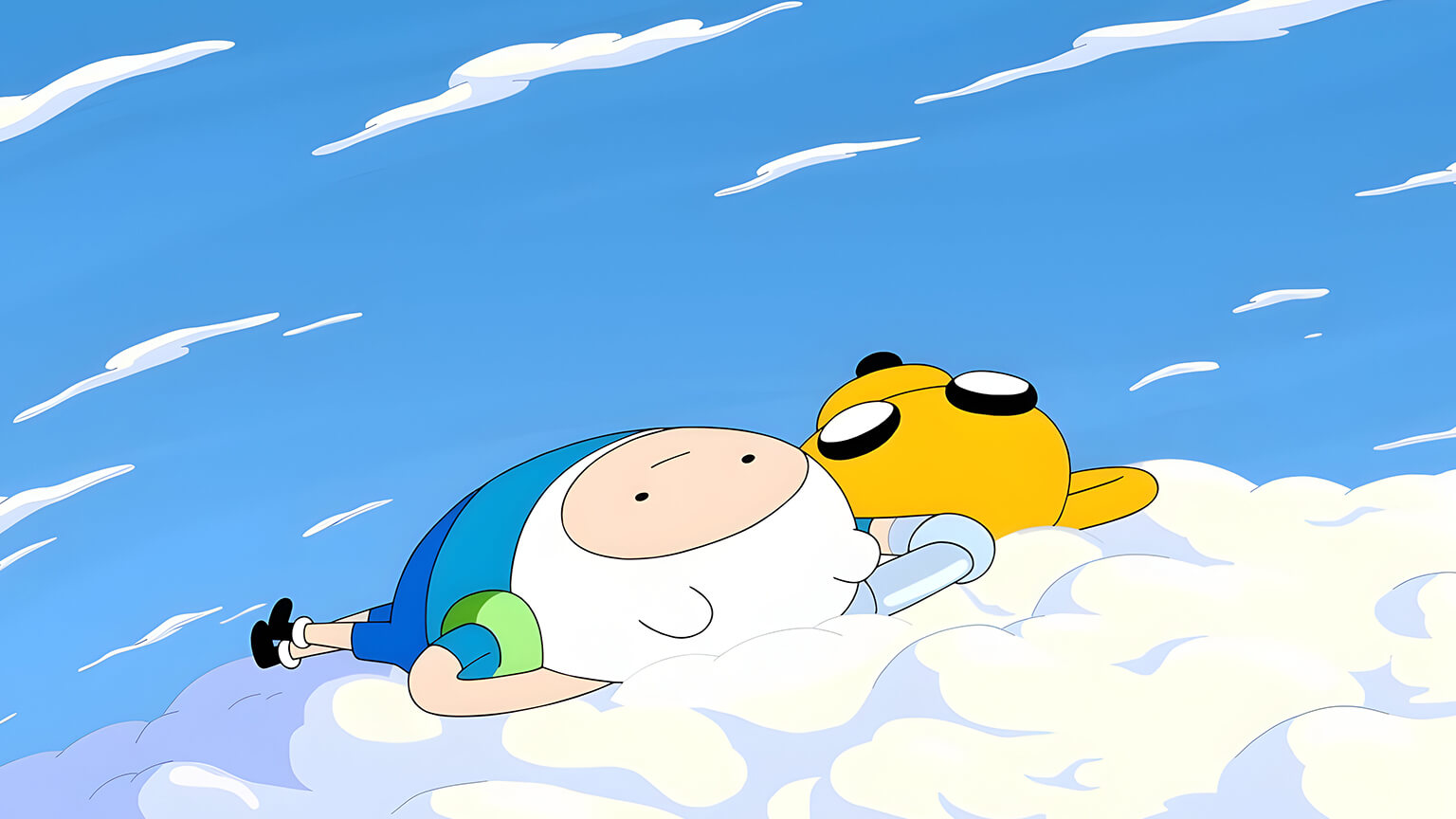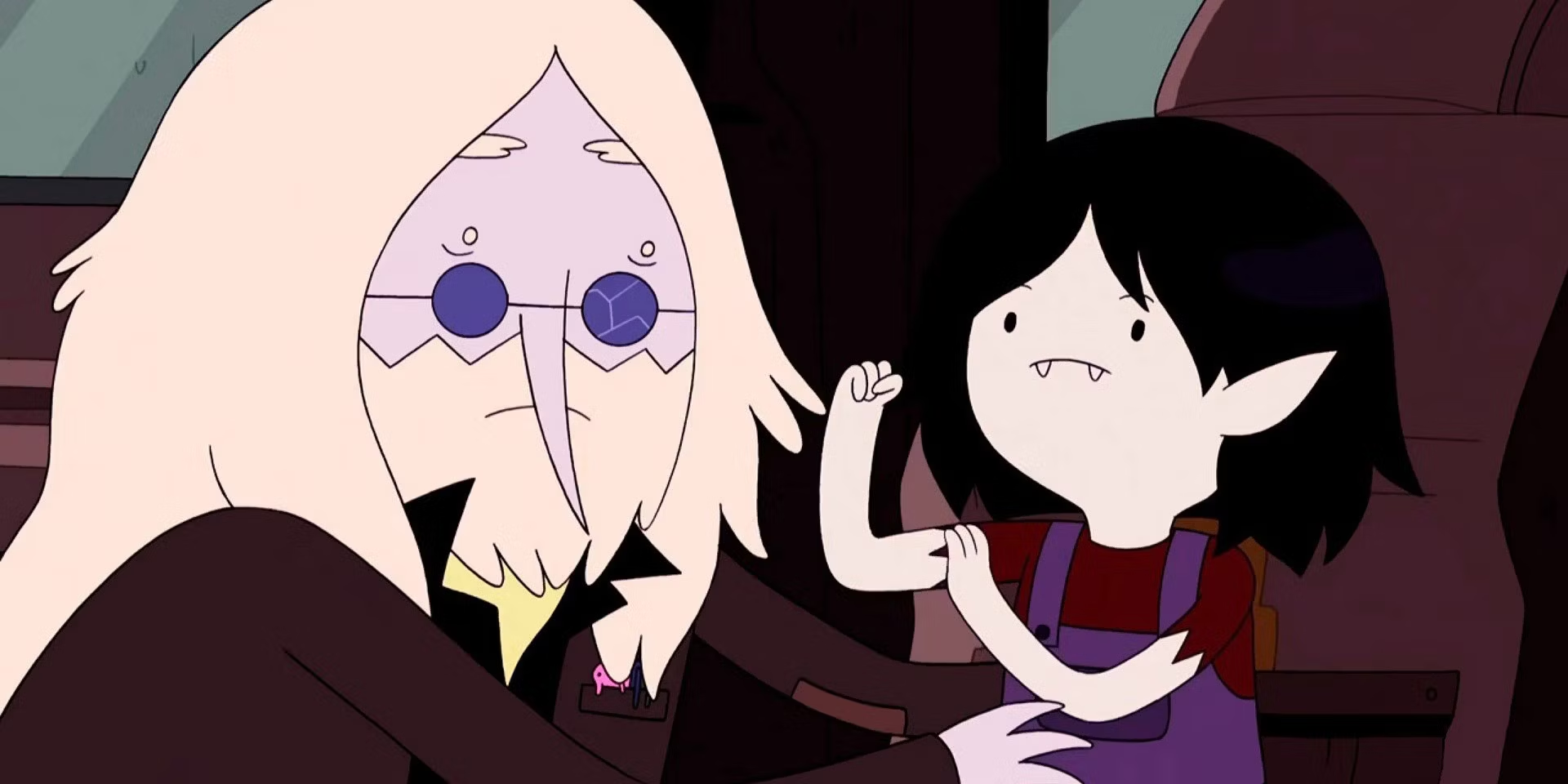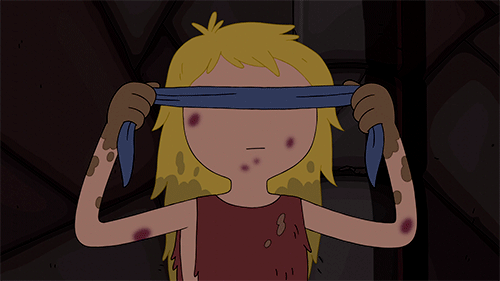By Jake Dixon

What makes a good modern or subversive fairy tale? Is it a story that changes an aspect of a fairy tale? Is it a fairy tale for adults? Is it a story that uses fairy tale elements that’s edgy? Adventure Time is a story that not many people would associate with fairy tales. Adventure Time is a cartoon that was made in 2010 by Pendleton Ward. It became a worldwide phenomenon, and went on for 10 seasons, with the last season ending in 2018. On a surface glance, the show seems childish, with the cartoon aesthetic as well as the goofy characters and absurd humor. Adventure Time in its earliest seasons uses the fairy tale formula in its storytelling, and later it slowly subverts and breaks down these formulas to deepen the characters, enhance its worldbuilding, and demonstrate its philosophy on growing up, happiness, and love.
Is Adventure Time even a fairy tale? To answer this question, a description of the show is needed. The simple premise of Adventure Time revolves around Finn the Human and Jake the Dog, and it follows them on adventures that they go on in the Land of Ooo. They often have to save Princess Bubblegum, as well as a myriad of other princesses from the grips of the ice king. He kidnaps princesses with the sole desire of forcing them to marry him. And at the end of every episode, Finn and Jake stop Ice King’s plots to marry the princess, and the status quo is returned. Finn is a courageous and charismatic young boy who would do anything to protect princesses and fight evil. Jake is a wise and carefree shapeshifting dog who often gives advice to Finn, and carries him where he needs to go. More often than not fairy tales have very shallow and simple characters, as well as an unspecified setting. Adventure Time ticks both of these boxes, which makes it bear a striking resemblance to a classic fairy tale. A noble prince, a princess in constant danger, and an evil king/wizard who takes princesses hostage.
Adventure Time characters have very little depth at the start. Most characters have a set personality and don’t develop from episode to episode. However, unlike Shrek, where it outright tells the audience that the movie is a subversion of the fairy tale world, Adventure Time slowly peels back the layers of the characters and the world and slowly breaks down the fairy tale formula one episode after another. Side characters begin to reappear from episodes prior and it expands on their personality traits, episodes begin to blend together with overarching stories. And the main cast begins to exhibit some form of depth. For instance, Finn has always had feelings for Princess Bubblegum, but she never reciprocates those feelings back, so Finn begins to break down and shut himself out from everyone around him. Finn isn’t a noble prince who saves the princess and lives happily ever after as portrayed at the start of the series. He is an emotionally unstable kid who doesn’t understand love. Princess Bubblegum isn’t exactly a helpless princess either. As the series progresses, Princess Bubblegum is shown to be very intrusive on her people. She has cameras everywhere in the candy kingdom and watches over everything and everyone. Princess Bubblegum is a dictator, who cares about her people deeply. She even committed genocide on a group of sentient guard robots she created, because they were fulfilling their programming of violence and held underground fights.
The breakdown of these archetypal characters extends to all the rest of the main cast, Jake the Dog, who is known for being wise and noble, was once a petty criminal who sometimes still slips into his old ways. Marceline the vampire, who is the least similar to a fairy tale archetype, but her character is still subversive. Vampires are viewed as cold blooded killers who have no regard for human life, which is what Marceline tries to project herself as at the start of the series. Yet as the series goes on, it is shown that she is shown to be incredibly emotional and caring, and the façade that she puts up is due to her past trauma of abandonment.
Out of all the characters that have more to them than meets the eye. The ice king is by far the one with the most depth. In the episodes titled “I Remember You”, and “Simon and Marcy”, the ice king’s backstory is revealed. Ice king was a normal man living in a world very similar to normal society, when the apocalypse happened. His real name was Simon, and he was Marceline’s adoptive father during the apocalypse. He had a crown that would give him ice powers, but in return every time he used it to protect Marceline, he would lose parts of himself to the crown. Eventually, he realized that he was becoming too dangerous, so he had to leave her alone in order to protect her from himself. We later learn that the reason he wants to be loved by princesses is because he lost his fiancé Betty because of the crown, and subconsciously the ice king wants to be loved again. This was the moment when the ice king turned from a villain to a victim of circumstance. It is a very clear allegory for mental illness, or more specifically dementia. Simon’s slow descent into madness and eventually him not being able to remember himself is very emblematic of Alzheimer’s disease. The National Institute of Aging states that symptoms of Alzheimer’s disease include memory loss, poor judgment, losing track of dates and times, mood and personality changes, and increased anxiety and aggression (NHIS 2022). Because of this revelation, many people around the ice king no longer treat him like a villain, and begin to exhibit more patience with him. Finn even begins to call him Simon.

(Simon and Marceline)
The final part of the fairy tale is the land of Ooo itself. Many fairy tales take place in unidentified locations at unidentified times. This makes the characters like Little Red Riding Hood or Rapunzel feel like they are omnipresent and beyond this world. This is what Ooo is like at the start of Adventure Time. Although the land of Ooo is named, the origins and where the land of Ooo exists is still a mystery. This makes it feel like it takes place out of our own universe of understanding. It builds up this narrative that it has no connection to the real world, and that no place could ever exist. But as the series goes on, and the fairy tale nature of the undisclosed setting falls, the true origins of Ooo is revealed. Around 1000 years before Adventure Time takes place, the world was very similar to our own, with coffee shops, businesses and regular humans. Until a tragic nuclear holocaust broke out that brought humanity as well as the rest of the world to the brink of extinction. This war was orchestrated by the Lich, the embodiment of death, whose only motivation is to watch all life die. As 1000 years passed, due to the war as well as its fallout, strange creatures and magic began to appear, creating what is now the land of Ooo. Grounding the setting in a reality similar to our own makes the story have way more stakes and the consequences of the war feel much more dire. As this could happen to us on any given day.
Next I want to analyze two episodes that perfectly encapsulate the messages and philosophies that Adventure Time is trying to teach. Puhoy is an episode that takes place inside a pillow fort, and is one of the most compelling episodes I have ever seen. It begins with Finn being distraught over him and Flame Princesses (one of Finn’s many love interests), and the fact that she didn’t laugh at his joke. He sees her not laughing as the end of their relationship, where Jake and BMO see it as a misunderstanding. Jake. trying to make Finn see how much he is overthinking uses a cup as a metaphor. “You see this cup, this is literally my favorite cup.” He then throws the cup out of the window, and says “Now it’s gone forever, so it’s not real, and I don’t care about it anymore!”. What Jake is saying is a clear example of living in the moment. He sees the cup as something that brought him joy, but as soon as it’s gone, there is no reason to dwell on it because it already happened, and there is nothing he can do to change it. Ignoring Jake’s advice, Finn crawls into the pillow fort they made to fester about his relationship with Flame Princess.
When Finn crawls in, he is met with a world that is fully made of pillows. When he stumbles in, the door disappears behind him. He then fights a pillow dragon and becomes the savior of the pillow town. He meets a girl named Roselinen, and ends up marrying and having two kids with her. As the episode goes on, he continues to fester about the door, and how he can find his way back to the real world. Even though Finn has built up a family and is happy in the pillow world, he can’t stop himself from overthinking about the world that he left behind. More years pass and Finn can’t even remember what his life was like before he entered the pillow fort. He misremembers what Jake looks like, and what he told him before he entered. He realizes that staying with the family he has is much more important, and festering about what he can’t change is only going to make him more unhappy. It’s implied that he spends the remaining days happy, where the last shot is him on his deathbed, surrounded by people he loves. He dies, and wakes up as a kid again in the pillow fort where he gets an unexpected call from Flame Princess, saying that she gets his joke and thinks it’s very funny. Jake asks him to recount his experience, where Finn says he can’t recall anything he just went through, and the episode ends.

(Finn on his deathbed in “Puhoy”)
The message of Puhoy may seem difficult to grasp, however I interpret this episode as the idea of a “silver lining” taken to the extreme, as well as a fight between living in the moment vs. living in the past. The first is the idea of a silver lining, which is defined by the Cambridge Dictionary as “an advantage that comes from a difficult or unpleasant situation” (Cambridge Dictionary). When Finn is transported to the pillow world, his only desire is to leave, and try to find a way out. His entire motivation, even when he has a wife and kids, is to escape and go back to the real world. When he realizes what he has built in this world, and what he would be leaving behind if he did find the door, he decides to make the best of a bad situation and stay with what he built. He is also living in the past, rather than seeing what is in front of him. The message that Jake gave to him at the start of the episode might have gone over his head, but he figured it out on his own. I believe that living in the moment and planning for the future is one of the major keys to happiness. “The past is now gone and nothing can be done about it. So fixating on it can prevent us from performing an action in the present – Living in the moment is very important for being happy. Happiness is nothing about which you have to think. You can only experience joy and happiness by feeling it in the present moment.” (Sonal Kalra 2021).
The next episode is The Hall of Egress, which I believe is the best episode of the entire show. It is about Finn being trapped in a dungeon, where the only way he can escape is by closing his eyes and navigating it blind. Finn enters a magical dungeon and is trapped inside, while Jake is left outside. Finn is met with 3 doorways, and pulls out a string from his shirt, where he states “better leave a trail in case I get lost, breadcrumbs style. Plus for if Jake gets in and tries to track me down”. He then falls down a sharp drop in one of the doorways, trapping him, and making the string idea useless. He meets a giant door that is called the “Hall of Egress”, in which the only way to walk through the Hall of Egress is if you close your eyes. And if you open them, you will be sent back to the dungeon. Finn tries to use a map but the layout changes every time, so he decides to run through as fast as he can until he finally reaches the surface. But when he opens his eyes, he is still sent back to the dungeon.
He makes it back up again, but Jake forces his eyes open. This happens over and over until Finn realizes he has to go off on his own and run through the wilderness blind, until something different happens. As he is running his shirt is caught on a log, and starts unraveling. He notices and says, “How long has this been going on? Someone’s apt to track me down, breadcrumbs style, e.g. Jake. I can’t let him catch me. No more threads to follow, no more Egress.” Finn runs for what seems like months throughout the wilderness until he eventually comes across a dungeon similar to the one he found himself trapped in. He runs into the door, this time solid when his eyes are closed. Shocked, he slowly takes off his three blindfolds. Once his eyes are opened, the dungeon is now clear. Finn runs through, seeing Jake through the walls, while Princess Bubblegum whispers “Hurry Finn, at the seashell’s center lies the cornucopia’s smallest door.” The episode ends with Finn, eyes wide open springing through the ground and hugging Jake.

(Finn taking off his blindfolds in “The Hall of Egress”)
This episode is about navigating through a difficult time in life. It is also about growing out of childhood and into adulthood. First, I want to break down what Princess Bubblegum meant by saying “at the seashell’s center lies the cornucopia’s smallest door.” According to Harper Crown, the symbolic meaning for a seashell is growth, transformation, and the journey of life (Harper Crown 2024). A cornucopia is the representation of abundance and prosperity, while the smallest door is imagined to be the hardest to fit through. So to put this all together, what Bubblegum was saying is that prosperity is awarded to those who struggle through life. In other words, those who go through the toughest times and push themselves to be better are able to see the beauty of life and the fruits of their labor. I also saw a striking resemblance with Hansel and Gretel, literally calling the thread “breadcrumb style”, when Finn uses the thread on his shirt to keep track of where he is. This is later contrasted with the second time the string of his shirt is leading him back, where he gets rid of it, and decides to trudge through the forest blind, whilst not looking back. This draws great parallels with Hansel and Gretel as they used Breadcrumbs to find their way back to their parents house. And when the breadcrumbs were eaten, they had to make their own path and navigate the forest by themselves. It could also be interpreted as a transition from childhood to adulthood. During this point in the story, Finn is 16, and about to reach the adult years of his life. The Hall of Egress, or exit, is a metaphor for leaving the childhood years behind, and the only way to find your way to happiness and to adulthood is if you run though it blind, and don’t look back.
Fairy tales in this day and age are seen as childish, and seen as a fantasy for parents to push morals onto kids. When most people think of fairy tales, they think of Disney movies and nursery rhymes. Adventure Time takes advantage of this viewpoint, the viewers comfortable with the one-dimensional characters of the early seasons. And when the characters are broken down into the complex characters that they eventually become, it makes it all the more shocking when the depth these characters have is given light. Adventure Time at its core is about childhood, and growing into people we were always destined to be. As Jake said, “It’s our natural state as people, to grow”. So why do I consider adventure time to be a subversive? I would define subversive as taking an idea or thing and fundamentally changing it to fit the mold of a new message or purpose. And that is exactly what Adventure Time does. It takes the fairy tale genre, and slowly breaks it down to show the soft inside of all the characters, as well as the world itself. While classic fairy tales messages may be “stranger danger” or “It’s what’s on the inside that counts”, Adventure Time subverts these types of messages and turns them into something bigger than itself. It breaks down aspects of life and shines light on taboo topics, which is only scratching the surface. It is truly one of the best and most innovative shows to ever come out.
References:
Silver lining definition | cambridge english dictionary. (n.d.-a).https://dictionary.cambridge.org/us/dictionary/english/silver-lining
What are the signs of alzheimer’s disease? | National Institute on Aging. (n.d.-b). https://www.nia.nih.gov/health/alzheimers-symptoms-and-diagnosis/what-are-signs-alzheimers-disease
Crown, H. (2024, January 18). Seashell symbolism and meaning. HarperCrown. https://www.harpercrown.com/blogs/topics/seashell-symbolism-and-meanings#:~:text=Seashell%20a%20Symbol%20of%20Transformation,power%20to%20cleanse%20and%20rejuvenate.